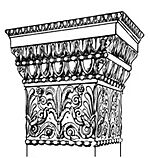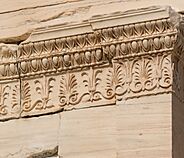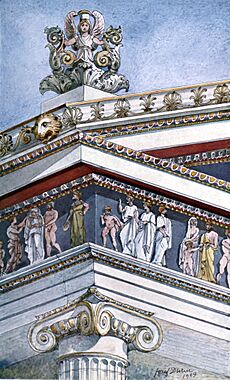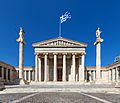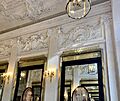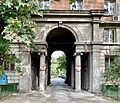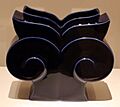Ionic order facts for kids
The Ionic order is one of the main styles of classical architecture. Think of it as one of the three "big brothers" of ancient Greek and Roman building styles, alongside the Doric and the Corinthian. There are also two smaller styles: the Tuscan (a simpler Doric) and the composite order (a fancy Corinthian). Among the three main styles, the Corinthian columns are the slimmest, followed by the Ionic, while the Doric columns are the widest.
The most famous part of an Ionic column is its volutes, which look like decorative scrolls or spirals at the top. Unlike Doric columns, Ionic columns usually stand on a base that separates the column from the floor or platform. The top part, called the capital, is often decorated with a pattern that looks like eggs and darts. The ancient architect Vitruvius thought the Ionic style looked like a woman, while the Doric style looked more masculine.
Contents
What Makes the Ionic Order Special?

The Capital: Scrolls and Designs

The most important part of the Ionic order is the volutes on its capital. These scrolls were carefully designed using simple tools like a ruler, a right-angle tool, string, and a compass. Sometimes, below the scrolls, the Ionic column has a wide band separating the capital from the fluted (grooved) column shaft. Other times, you might see carvings of fruit and flowers hanging from the scrolls.
At first, the scrolls were flat, facing only one way. But then, architects realized they could angle the scrolls outwards at the corners of buildings. This made the Ionic order look better from different angles, whether you were looking at the front or the side of the building. This was a big improvement over the Doric style for corner columns. However, some artists felt this "bent" the rules of design. The Corinthian order later solved this problem by having capitals that looked good from all sides. In the 16th century, a famous architect named Vincenzo Scamozzi designed a four-sided Ionic capital that became very popular. When the original Greek Ionic style came back in the 18th century, it felt fresh and classic.
Columns and the Top Structure
The Ionic column is always thinner than the Doric column. Because it's thinner, it always needs a base to stand on. Ionic columns are usually eight to nine times taller than their width.
Most Ionic columns have flutes, which are the hollow grooves running down the shaft. After some early tries, architects decided on 24 flutes. This made sure the flutes looked right no matter how tall the column was. Unlike Doric flutes, which have sharp edges that could get damaged, Ionic flutes have a small flat space between each groove.
Sometimes, the flutes were left out. For example, the English architect Inigo Jones used plain Ionic columns on his Banqueting House, Whitehall in London to give it a more serious look. Also, when architect John Russell Pope designed the Theodore Roosevelt memorial in New York City, he used huge unfluted Ionic columns to show strength and intelligence.
The entablature is the structure that rests on top of the columns. It has three parts:
- A plain architrave, which is like a beam, usually divided into two or three bands.
- A frieze on top of the architrave, which can be richly carved with pictures or stories. This is different from the Doric order, which has triglyphs (vertical grooves) in this area.
- A cornice at the very top, which has dentils (small block-like shapes, like the ends of roof beams) and other decorative moldings to support the projecting roof.
Anta Capital: Wall Ends
An Ionic anta capital is the special top part of an anta, which is the front edge of a supporting wall in Greek temples. These capitals are designed to be flatter so they don't stick out too much from the wall.
Unlike the regular column capitals, Ionic anta capitals are often very decorated. They usually have bands of alternating lotuses and flame palmettes, as well as patterns like eggs and darts and beads and reels. These decorations help them connect smoothly with the decorative frieze along the top of the walls. In Roman times, the anta capitals started looking more like the column capitals. You can see great examples of Ionic anta capitals with their floral patterns at the Erechtheion temple, built around 410 BCE.
History of the Ionic Order
The Ionic order first appeared in the mid-6th century BC in Ionia, which is now part of modern-day Turkey. This was a region settled by the Ionians, who spoke Ionic Greek. By the 5th century BC, the Ionic column style was also being used in mainland Greece. It was very popular in Ionia during the Archaic Period (750-480 BC).
One of the first big Ionic temples was the Temple of Hera on Samos, built around 570–560 BC. Sadly, it was destroyed by an earthquake just ten years later. A more lasting Ionic temple from the 6th century was the Temple of Artemis at Ephesus, which was one of the Seven Wonders of the Ancient World. The famous Parthenon in Athens is mostly Doric, but it also has some Ionic parts. A very pure example of the Ionic style on the Athenian Acropolis is the Erechtheum.
After Alexander the Great conquered lands to the east, you can find a few examples of the Ionic order as far away as Pakistan, like the Jandial temple near Taxila. Some capitals with Ionic influences have even been found in Patna, India, such as the Pataliputra capital from the 3rd century BC, which looks like an Ionic anta capital. The Sarnath capital has also been described as "Persian-Ionic" or "almost Ionic."
Vitruvius, an architect who lived during the time of Augustus, wrote that the Doric column was based on the male body, while Ionic columns were inspired by the "slenderness" of the female body. While we don't know his exact source, this idea likely came from earlier Greek architects. Later, during the Renaissance, architects saw the Ionic order as graceful and civilized, making it a good choice for libraries and courthouses.
From the 17th century onwards, a very admired version of the Ionic order was seen in the Temple of Fortuna Virilis in Rome. This design was widely copied after it was shown in detailed drawings by Antoine Desgodetz in 1682.
Images for kids
-
Ancient Greek Archaic Ionic capital of the Sphinx of Naxos, around 560 BC, Naxian marble, Delphi Archaeological Museum, Delphi, Greece
-
Ancient Greek Ionic columns in the Temple of Apollo at Bassae, Bassae, Greece, illustration by Charles Robert Cockerell, unknown architect, around 429-400 BC
-
Compared Ionic order with Doric, Tuscan, Corinthian and Composite orders; with stereobate
-
Ancient Near Eastern Ionic columns of a rock-cut tomb at Qyzqapan, Iraq, unknown architect, 5th-4th centuries BC
-
Roman Ionic columns of a colonnade of the oval plaza in Jerash, Jordan, unknown architect, 2nd-3rd centuries AD
-
Byzantine Ionic capital in the Hagia Sophia, Istanbul, Turkey, by Anthemius of Tralles or Isidore of Miletus, 6th century
-
Renaissance Ionic columns of the Villa La Rotonda, outside Vicenza, Italy, by Andrea Palladio, 1567-1605
-
Baroque Ionic columns in the Santi Luca e Martina, Rome, by Pietro da Cortona, 1634-1669
-
Baroque Ionic columns on the garden façade of the Palace of Versailles, Versailles, France, by Jules Hardouin-Mansart, 1678–1688
-
Baroque Ionic columns in the Karlskirche, Vienna, Austria, 1715–1737, by Johann Bernhard Fischer von Erlach
-
Baroque Solomonic Ionic columns of the Monastery of San Francisco, Antigua, Guatemala, unknown architect, early 17th century
-
Rococo Ionic pilasters on the facade of the Amalienburg, Nymphenburg Palace Park, Munich, Germany, by François de Cuvilliés, 1734-1739
-
Rococo pilasters on the facade of the Église Saint-Jacques de Tarascon, Tarascon, France, by Jean-Baptiste Franque and Antoine Damour, 2nd half of the 18th century
-
Neoclassical Ionic columns at Syon House, London, by Robert Adam, around 1761-1765
-
Louis XVI style caryatids with Ionic capitals on their heads, on a jewelry locket of Marie-Antoinette, by Ferdinand Schwerdfeger, 1787, mahogany, mother-of-pearl inlays, paintings under glass, porcelain plate, and gilded bronzes, Chambre de la Reine, Palace of Versailles, Versailles, France
-
Greek Revival Ionic columns of the Branch Bank of the United States, now in the Charles Engelhard Court of the Metropolitan Museum of Art, New York City, inspired by those of the Temple of Artemis Agrotera in Athens, by Martin E. Thompson, 1824
-
Neoclassical Ionic capital with a festoon between its volutes, part of the entrance portico of the Villa Eilenroc, Antibes, France, by Charles Garnier, 1860-1867
-
Art Nouveau railing with highly stylized reinterpretations of the Ionic column as balusters, on the France-Lanord Building (Avenue Foch no. 71), Nancy, France, by Émile André, 1904
-
Beaux Arts Ionic columns on the facade of the Ducourneau Theater, Agen, France, by Guillaume Tronchet, 1906-1908
-
Polychrome Greek Revival Ionic capitals in the Washington Union Station, Washington, D.C., US, by Daniel Burnham, around 1907
-
Conspicuous Greek Revival Ionic capital in the New Orleans Museum of Art, New Orleans, US, inspired by those of the Erechtheum in Athens, by Samuel Abraham Marx, 1911
-
Neoclassical Ionic columns in a Secessionit poster, by Franz Stuck, 1911, lithograph, Poster Collection of the Basel School of Design, Basel, Switzerland
-
Art Deco and Neoclassical Ionic pilasters in the Severance Hall, Cleveland, US, by Walker and Weeks, 1931
-
Postmodern reinterpretation of the Ionic column as the Capitello seating, designed by Studio 65 and produced by Gufram, differentiated-density polyurethane foam coated with latex rubber, 1972, unknown location
-
Postmodern vase inspired by the Ionic capital, designed by Michael Graves for Swid Powell, 1989, glazed porcelain, Indianapolis Museum of Art, Indianapolis, US
-
New Classical Greek Revival Ionic columns in the Gonville and Caius College Hall, Cambridge, UK, inspired by those from the Temple of Apollo at Bassaem by John Simpson, 1998
-
Postmodern reinterpretations of Ionic columns of the Jacksonville Public Library, Jacksonville, US, by Robert A. M. Stern, 2005
See also
 In Spanish: Orden jónico para niños
In Spanish: Orden jónico para niños


